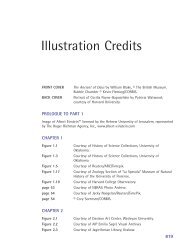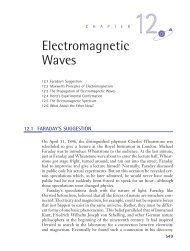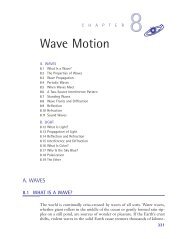Chapter 9: Einstein and Relativity Theory (319 KB) - D Cassidy Books
Chapter 9: Einstein and Relativity Theory (319 KB) - D Cassidy Books
Chapter 9: Einstein and Relativity Theory (319 KB) - D Cassidy Books
You also want an ePaper? Increase the reach of your titles
YUMPU automatically turns print PDFs into web optimized ePapers that Google loves.
3637_<strong>Cassidy</strong>TX_09 6/14/02 12:08 PM Page 415<br />
9.4 CONSTANCY OF THE SPEED OF LIGHT 415<br />
as the laws governing light <strong>and</strong> other effects of electromagnetism, not just<br />
mechanics. <strong>Einstein</strong> used this principle as one of the two postulates of his<br />
theory of relativity, from which he then derived the consequences by deduction.<br />
<strong>Einstein</strong>’s Principle of <strong>Relativity</strong> states:<br />
All the laws of physics are exactly the same for every observer in<br />
every reference frame that is at rest or moving with uniform relative<br />
velocity. This means that there is no experiment that they can<br />
perform in their reference frames that would reveal whether or not<br />
they are at rest or moving at uniform velocity.<br />
Reference frames that are at rest or in uniform velocity relative to another<br />
reference frame have a technical name. They are called inertial reference<br />
frames (since Newton’s law of inertia holds in them). Reference frames<br />
that are accelerating relative to each other are called noninertial reference<br />
frames. They are not included in this part of the theory of relativity. That<br />
is why this part of the theory of relativity is called the theory of special relativity.<br />
It is restricted to inertial reference frames, those which are either at<br />
rest or moving with uniform velocity relative to each other.<br />
Notice that, according to <strong>Einstein</strong>’s <strong>Relativity</strong> Principle, Newton’s laws<br />
of motion <strong>and</strong> all of the other laws of physics remain the same for phenomena<br />
occurring in any of the inertial reference frames. This principle<br />
does not say that “everything is relative.” On the contrary, it asks you to<br />
look for relationships that do not change when you transfer your attention<br />
from one moving reference frame to another. The physical measurements<br />
but not the physical laws depend on the observer’s frame of reference.<br />
9.4 CONSTANCY OF THE SPEED OF LIGHT<br />
The <strong>Relativity</strong> Principle is one of the two postulates from which <strong>Einstein</strong><br />
derived the consequences of relativity theory. The other postulate concerns<br />
the speed of light, <strong>and</strong> it is especially important when comparing observations<br />
between two inertial reference frames in relative motion, since we<br />
rely chiefly on light to make observations.<br />
You recall that when <strong>Einstein</strong> quit high school at age 15 he studied on<br />
his own to be able to enter the Swiss Polytechnic Institute. It was probably<br />
during this early period that <strong>Einstein</strong> had a remarkable insight. He<br />
asked himself what would happen if he could move fast enough in space to<br />
catch up with a beam of light. Maxwell had shown that light is an electromagnetic<br />
wave propagating outward at the speed of light. If Albert could






